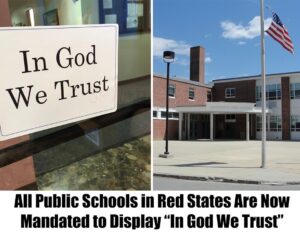
The intricate dance between education, politics, and religion in the U.S. has never been more pronounced. One recent turn in this ballet is the decision in red states — traditionally conservative or Republican-leaning regions — to mandate the display of “In God We Trust” in all public schools.
While the national motto isn’t a recent addition to the American lexicon, its explicit presentation in the educational realm is a subject of intense debate. This expansive exploration aims to delve into the rich tapestry of arguments, history, and implications surrounding this mandate.
“In God We Trust” didn’t emerge in the latter half of the 20th century as some might think. Its roots trace back to the Civil War, an era of profound division and upheaval. First imprinted on U.S. coins, the motto became a beacon of unity in a fragmented nation.Its elevation to the status of national motto in 1956, amidst the Cold War, further entrenched its significance. As America grappled with ideological adversaries, namely the atheistically-inclined Soviet Union, “In God We Trust” became both a rallying cry and a stark counterpoint to the opposing worldview.
However, shifting this motto from coins and general parlance into the classrooms is a transition rife with complexities. Before dissecting the arguments for and against this decision, it’s crucial to understand why red states, in particular, have championed this movement.The U.S., like many nations, often grapples with defining its identity. For supporters, displaying the motto is more than a nod to tradition; it’s about cementing a shared cultural narrative in the minds of the young. They argue that as students navigate their formative years, a constant reminder of national unity can instill a sense of belonging and common purpose.In a rapidly evolving world, many feel that society is drifting from its spiritual moorings. By placing “In God We Trust” prominently in schools, proponents believe that this can serve as a gentle nudge towards spiritual reflection and, possibly, rekindling a collective faith.
The world of politics is rarely straightforward. Critics argue that beneath the surface of faith and unity lies a more calculated move. They believe that this mandate is a strategic maneuver, a way to assert a dominant cultural narrative, especially in a space as influential as the educational system.The First Amendment, while clear in its wording, has been a fertile ground for countless debates. The crux of this argument revolves around how one interprets the “establishment of religion” and the implied “separation of church and state.” Advocates for the display argue that the motto doesn’t champion a specific religious tradition.
Instead, it’s a broad affirmation of trust in a higher power, aligning with America’s historical values. They posit that the First Amendment seeks to prevent the establishment of a state religion, not eliminate all religious undertones from public entities.
Detractors see the mandate as a precarious step towards mingling religious teachings with state functions. They fear that such decisions, even if well-intentioned, can alienate non-believers or those of other faiths. For them, the essence of the First Amendment lies in preserving a neutral space, free from potential religious bias.
The real-world ramifications of this decision reverberate beyond political chambers, affecting the very fabric of American schooling. Modern classrooms are microcosms of the broader society. With students hailing from diverse backgrounds, religious beliefs, and personal philosophies, the motto could resonate differently.
While some may see it as a mere historical artifact, others might perceive it as an ideological imposition. A few educators express concerns that such mandates shift the focus from primary educational goals. At a time when global competitiveness hinges on innovation, creativity, and critical thinking, some argue that debates like these distract from more pressing educational challenges.
Every coin has two sides. The presence of the motto offers an invaluable opportunity for educators. It can serve as a springboard for discussions about the nation’s history, the concept of religious freedom, and the broader challenges of integrating faith in public life.
The mandate to display “In God We Trust” in public schools is undeniably polarizing. While it harks back to the foundational elements of America’s story, it also challenges modern interpretations of inclusivity and neutrality.



